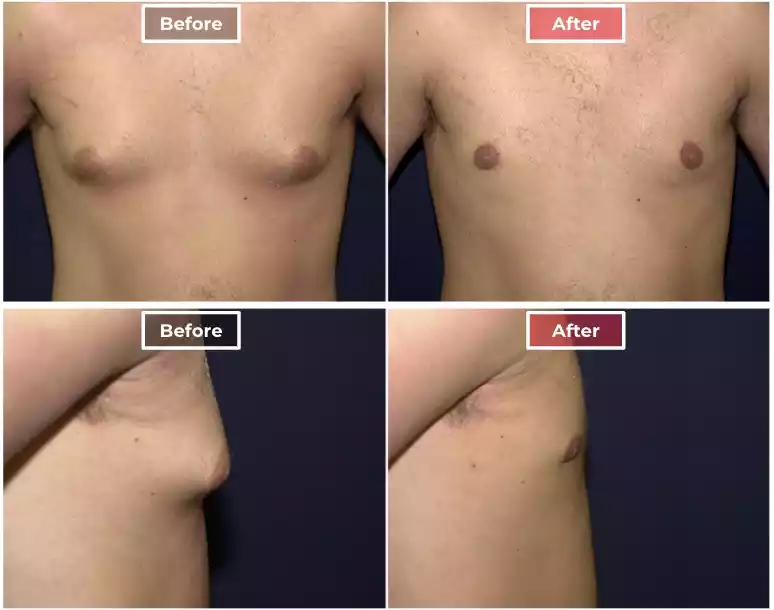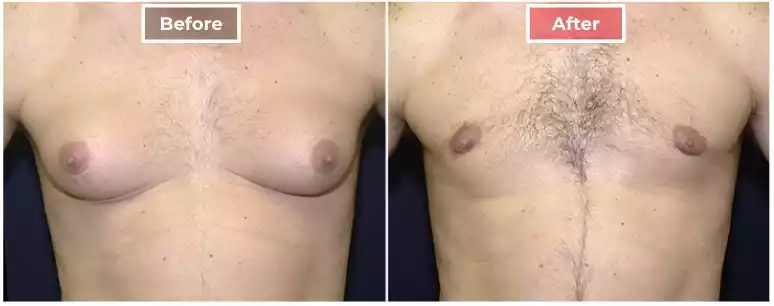Gynecomastia(opens in a new tab) is known colloquially as man boobs. It is caused by breast tissue, an artifact of the hormonal imbalance that hits all boys during puberty. The condition is quite common in men of all ages. Although you don't hear much about this condition, experts say it may affect as many as 50 to 70 percent of men to varying degrees throughout their lives(opens in a new tab) (1).
Breast reduction surgery for men removes unwanted fullness in the chest area revealing the underlying Pectoral muscle contours of the normal male chest. It also helps to relieve discomfort from this developmental condition. It can improve self-image.
At our Shadyside office in Pittsburgh, PA., Dr. Avery Capone treats many men with gynecomastia and performs male breast reduction procedures. For more information, call our Shadyside office at (412) 363-6626 or book an appointment online to effortlessly schedule a consultation with Dr. Capone today!

Puberty, aging and certain health conditions can create unwanted fullness in male breast tissue. This swollen tissue is known as gynecomastia, and is much more common than you may think. Dr. Capone has years of experience performing male breast reduction to create the firmer, flatter chest men want to feel more confident in their appearance. Consider an evaluation with Dr. Capone today!


Gynecomastia is enlarged breast tissue in men that forms under the nipple(opens in a new tab). It’s not a critical or dangerous condition, but it can be embarrassing. Although the enlargement may be bigger on one side versus the other, in most cases, both breasts are affected.
Research shows that this abnormality is typically caused by a hormonal imbalance beginning in puberty. It also can be triggered by certain prescription drugs or excessive smoking of marijuana(opens in a new tab) (2). In athletes, gynecomastia usually develops as a result of steroid use.(opens in a new tab)
The condition starts as a little lump under the nipple, usually during puberty(opens in a new tab). The lump tends to go away with time, but not in all cases. Sometimes it gets bigger, causing the nipple to stick out. In a boy who's a little overweight, the chest might really start to look more like his sister's chest with early breast development.
No, but if the gynecomastia is significant, you may be socially isolated,(opens in a new tab) including avoiding sports and time with friends. Patients that suffer from gynecomastia will sometimes try to avoid situations where they would need to take their shirt off. Gynecomastia can be incredibly embarrassing, but it is treatable. Rarely, gynecomastia can lead to breast cancer in men, a condition typically associated with woman. Breast cancer is certainly a dangerous condition.
A lot of guys just ignore it, hoping it'll go away. Others try diet and exercise to reshape their chest. However, the only way to truly take care of it is surgery. Liposuction is an important tool when the lump is associated with the excessive surrounding of fatty tissue. The excess skin can also be removed, to create a flatter, firmer chest. Dr. Capone will discuss your surgery options and recommend a treatment plan to fit your aesthetic and surgical ideals. Typically, the surgery lasts about an hour or two.
You will only be able to do sedentary activities immediately after surgery. About the third week post-surgery, you will be able to start sweating with cardio and can resume lifting weights. Patients should avoid chest training for three weeks to avoid fluid accumulation(opens in a new tab) or other problems in the surgical area. After that, they should start back slowly. Most patients are back to normal within three weeks.
For more information about our male breast reduction or body contouring procedures, schedule a consultation at our Pittsburgh, Pennsylvania cosmetic surgery center. We will be happy to discuss your male breast reduction options, as well as answer your questions about recovery following surgery.
References:
Our experienced care professionals are happy to assist you with any questions or comments.
Use Our Online Booking Tool to effortlessly Request an Appointment or call our office today!